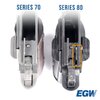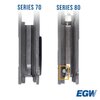The series 70 has less moving parts.What's the difference between a series 80 and 70
You are using an out of date browser. It may not display this or other websites correctly.
You should upgrade or use an alternative browser.
You should upgrade or use an alternative browser.
Series 80 70
- Thread starter deadeye dick
- Start date
- Status
-
Not open for further replies.
My first 1911 was a Colt Mk IV Series 70. I liked the collet bushing but I did have a finger break off the bushing, jam the gun and crack the frame where the dust shield attaches to the rest of the frame. The collet bushing needed to be a part requiring regular interval replacement.
When Colt brought out the Series 80, I remember the comments were the Series 80 trigger could never be tuned to be as good as the Series 70 triggers. I think that is no longer the case but I think most prefer to build competition guns around triggers without the firing pin safety.
I’ve built several 1911’s and all are without the firing pin safety. I did build one with the S&W style external extractor. I prefer the internal extractor after the “experiment”.
I have two or three Colt Series 80 guns purchased in the last 10-15 years. I do not really see any difference in the trigger from a non-modified Series 70 trigger. But, I don’t plan on working on the Series 80 triggers.
I have a Kimber Eclipse II and two SIG 1911 pattern guns. I never thought of them as Series 80 guns. The Kimber is a 38 Super and the SIGs are 40 S&W and 357 SIG.
In building a 1911, the Series 70 and Series 80 nomenclature is useful for getting the proper parts. But I’ll agree, it a Colt model designation and probably should not be used except for Colt pistols.
Finally, that cracked Series 70 frame now sports a 22LR slide and barrel. I figure it can handle 22LR and I get a dandy 22LR to practice with.
When Colt brought out the Series 80, I remember the comments were the Series 80 trigger could never be tuned to be as good as the Series 70 triggers. I think that is no longer the case but I think most prefer to build competition guns around triggers without the firing pin safety.
I’ve built several 1911’s and all are without the firing pin safety. I did build one with the S&W style external extractor. I prefer the internal extractor after the “experiment”.
I have two or three Colt Series 80 guns purchased in the last 10-15 years. I do not really see any difference in the trigger from a non-modified Series 70 trigger. But, I don’t plan on working on the Series 80 triggers.
I have a Kimber Eclipse II and two SIG 1911 pattern guns. I never thought of them as Series 80 guns. The Kimber is a 38 Super and the SIGs are 40 S&W and 357 SIG.
In building a 1911, the Series 70 and Series 80 nomenclature is useful for getting the proper parts. But I’ll agree, it a Colt model designation and probably should not be used except for Colt pistols.
Finally, that cracked Series 70 frame now sports a 22LR slide and barrel. I figure it can handle 22LR and I get a dandy 22LR to practice with.
herrwalther
Member
- Joined
- May 1, 2013
- Messages
- 8,130
The four fingered sear spring is a Clark product and has nothing to do with the Series 80 parts. My FLG used them for a while - I probably have one in some gun or another he worked on - but reverted to standard.
I stand corrected. Only 4 leaf sear springs I have seen were on series 80 1911s so I just assumed they went together.
D&L is the only higher end 1911 maker I know of that uses series 80/firing pin blocks.You are not going to find a Wilson Combat, Nighthawk , Ed Brown or Alchemy Gun Works in an 80 series.
@deadeye dick - To answer your original question, the Colt Series 80 pistols (and copied by many other manufacturers) had extra components to create a “trigger safety” that had to be engaged to release the firing pin. It was designed to make them “drop safe”.

The easiest way to determine if you have it is to look at the frame - you’ll see the safety lever in the Series 80 but not the Series 70.

You can also check the slide:


The easiest way to determine if you have it is to look at the frame - you’ll see the safety lever in the Series 80 but not the Series 70.

You can also check the slide:

deadeye dick
Member
@deadeye dick - To answer your original question, the Colt Series 80 pistols (and copied by many other manufacturers) had extra components to create a “trigger safety” that had to be engaged to release the firing pin. It was designed to make them “drop safe”.
View attachment 1120532
The easiest way to determine if you have it is to look at the frame - you’ll see the safety lever in the Series 80 but not the Series 70.
View attachment 1120533
You can also check the slide:
View attachment 1120534
Thank you very much. That is exactly what i want to know. Be well Howie
AlexanderA
Member
The innovation of the Series 70, as compared to earlier Colts, was the spring collet bushing, combined with a swell at the muzzle end of the barrel. The idea was that the barrel would precisely return to the same position, shot after shot. The spring collet was eventually dropped. (I had an actual Series 70 with the collet bushing, and hated it.)
"Series 70," now, simply means that the gun lacks the Series 80 firing pin safety. This is a misnomer. A better terminology would be "pre-Series 80."
In low-price guns, the RIA/Armscor ones are "Series 70" while the Thompson/Kahr ones are "Series 80." This is important to know if you are trying to build a mil-spec WW2 clone.
"Series 70," now, simply means that the gun lacks the Series 80 firing pin safety. This is a misnomer. A better terminology would be "pre-Series 80."
In low-price guns, the RIA/Armscor ones are "Series 70" while the Thompson/Kahr ones are "Series 80." This is important to know if you are trying to build a mil-spec WW2 clone.
Jim Watson
Member
Some of the early WWII commercial to military conversions have cuts for the Swartz firing pin block but no parts. So they had been thinking about it for a long time.
Rock185
Member
The discussion and illustrations have pretty well covered the 70/80 differences. I've had 1911 type guns with and without FPS, and am comfortable with both. But when I had the opportunity to carry a 1911 type pistol in police work, the only one authorized was the Series 80 Colt. This, precisely because the Series 80 Colt did have a FPS. FWIW, factory trigger pull weight specs between 70 and 80 Series Colts did not change. And I know for a fact that clean, safe trigger pulls down to 3 1/2# are achievable with all Series 80 components intact.
I have seen and read of some stupid stuff done which led to problems with the Series 80 guns. But I haven't seen any issues with Colt Series 80 guns where the Series 80 components were not monkeyed with...
I have seen and read of some stupid stuff done which led to problems with the Series 80 guns. But I haven't seen any issues with Colt Series 80 guns where the Series 80 components were not monkeyed with...
halfmoonclip
Member
- Joined
- Feb 4, 2011
- Messages
- 2,769
Gotta say detail stripping a Series 80 can be kind of an aggravation, on reassembly. The Series 70 is certainly easier.
Got tangled in a discussion elsewhere about just how drop-safe the original 1911 was. Presume the issue was just how far, on to what kind of surface, a 1911 had to fall, muzzle down, to discharge. Estimates ranged between 'waist high' and '20 feet', on to a steel deck.
Also presume many Series 70 guns (in the generally accepted meaning of the term; exceptions duly noted) now have titanium firing pins, to solve the muzzle down drop issue, whatever it may be.
Moon
Got tangled in a discussion elsewhere about just how drop-safe the original 1911 was. Presume the issue was just how far, on to what kind of surface, a 1911 had to fall, muzzle down, to discharge. Estimates ranged between 'waist high' and '20 feet', on to a steel deck.
Also presume many Series 70 guns (in the generally accepted meaning of the term; exceptions duly noted) now have titanium firing pins, to solve the muzzle down drop issue, whatever it may be.
Moon
Jim Watson
Member
There is a table on the www somewhere showing 1911 types without firing pin obstructions firing from maybe a 3 foot drop on concrete.
When I ran my own drop tests, I was releasing from head height onto a linoleum over wood floor with no fires. I did not have guide rails but I made the multiple drops it took to see the gun land in the orientations I wanted.
When I ran my own drop tests, I was releasing from head height onto a linoleum over wood floor with no fires. I did not have guide rails but I made the multiple drops it took to see the gun land in the orientations I wanted.
JTQ
Member
Drake Oldham 1911 drop testThere is a table on the www somewhere showing 1911 types without firing pin obstructions firing from maybe a 3 foot drop on concrete.
http://dave2.freeshell.org/1911/drop1/drop1.htm
Bcwitt
Member
Ive never heard of a 1911 being sensitive to drop firing. Seems very unlikely. Especially with the grip safety. Was there an incodent or accident that propted the design change?
trackskippy
Member
- Joined
- Oct 2, 2010
- Messages
- 3,495
Up until the Series 80's, the 1911's didnt have a firing pin block. The grip safety, assuming its functioning correctly, only blocks the trigger.
JTQ
Member
Ive never heard of a 1911 being sensitive to drop firing. Seems very unlikely. Especially with the grip safety. Was there an incodent or accident that propted the design change?
Colt developed the Swartz firing pin safety in the 1930's. Since consumer lawsuits were probably not as common as they are today, the assumption would be there was a problem noted and a safety design was developed. Presumably, if not for WW II, all Colt 1911's would have had a firing pin safety by around 1940.Up until the Series 80's, the 1911's didnt have a firing pin block. The grip safety, assuming its functioning correctly, only blocks the trigger.
Jim Watson
Member
We know they had the Swartz firing pin obstruction before WWII but did not use it on military production, not in the Mil-Spec.
The surprising part is that they did not resume installing it when they got back into commercial production after the war.
If you want to know how the Swartz system works, look at a Kimber Series II.
The surprising part is that they did not resume installing it when they got back into commercial production after the war.
If you want to know how the Swartz system works, look at a Kimber Series II.
- Status
-
Not open for further replies.
Similar threads
- Locked
- Replies
- 22
- Views
- 1K
- Replies
- 11
- Views
- 1K


